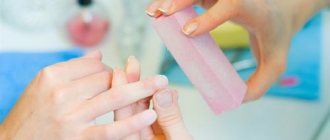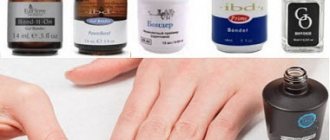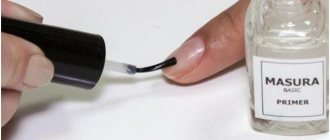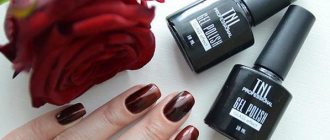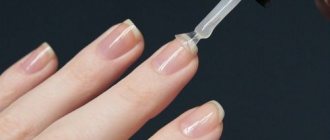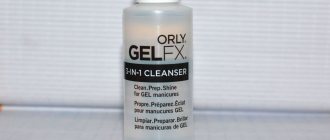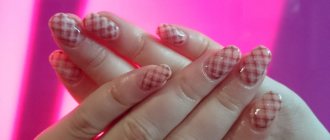The correct technique and sequence of its implementation allows you to extend the “life” of a manicure; the moment when you apply primer to your nails under gel polish largely determines its durability. Our nails are smooth by nature, so acrylic or gel, gel polishes do not stick well to them. The role of special fastening is played by the primer, which makes the surface rougher. It is easy to use and requires no special training or equipment.
Primers come in different types. Some are used more for extensions, others for regular manicure with gel polish. Our article will help you understand the nuances of application and choice of product.
What is a nail primer?
Nail primer is the basis for manicure (nail extension). The liquid is often used to strengthen the natural surface when using acrylic or gel materials. Thanks to the proper use of this liquid, the artificial manicure will last much longer and your nails will remain less deformed.
Nail primer (what it is and how to apply it is described below) is a liquid without fragrance or color. Primers are sold in glass bottles with a brush for ease of application. To ensure greater safety of the product, the bottle is made opaque to protect it from sunlight.
Developing companies do not add flavors or dyes to ensure safety for people with hypersensitivity or allergies. The nail fluid dries out very quickly, which can be seen when a white coating appears after treatment. This means that you can continue to work with extensions.
Why do you need a nail primer?
The primer is widely in demand in professional salons and when doing manicure work yourself.
Depending on the type of work and materials, specialized liquids vary somewhat, but the main tasks for all types are the same:
- guarantees comprehensive protection of the natural nail plate from the appearance of yellow plaque, peeling, and the formation of fungal microflora;
- By avoiding the use of a primer, there is a likely risk of a “greenhouse effect” appearing between the natural and artificial nail plate. This entails the formation of harmful microorganisms under extended nails;
- effective gluing of the extended surface. The durability of the manicure depends on the quality and reliability of the primer;
- functional degreasing of the nail before extensions.
Don't miss the most popular article in the section: How to draw monograms on nails step by step for beginners. Instructions with photos.
The best companies
What is a nail primer and why it is needed is now clear, all that remains is to review popular products.
Lady Victory acid-free primers perfectly degrease, provide reliable adhesion and prevent peeling of the coating. Ideal for beginner manicurists due to the absence of acidic substances in the composition. Price range from 80 rub. up to 350r. Manufacturer – China.
Le Vole Ultra Bond is ideal for working with gel and acrylic. The compositions of this brand disinfect and clean the nail well, while maintaining the natural pH level. Price range from 250 rub. up to 400 rub. Manufacturer – USA.
Kodi Professional Ultrabond has a gentle composition, without methacrylic acid. Used when working with gel and for acrylic extensions. Average price – 450 rub. Manufacturer – USA.
EZ Flow produces products without dyes or fragrances. The brand's primer dries quickly, leaving a white residue. The brand produces all types of materials for working with different nail coatings. Production - USA. Price range from 500 rub. up to 1100 rub.
IBD has been known on the market for over 30 years. The brand produces products suitable for people with hyperhidrosis and very brittle nails. IBD stick contains methacrylic acid, which prevents peeling of materials. Product cost from 300 rub. up to 900 rub. Manufacturer – USA.
Runail Professional Primer Acrylic System produces a product for acrylic extensions. Has excellent adhesive ability. Manufacturer – Russia. Price from 200 rub.
Yoko APR-15 is suitable for both gel and acrylic. This primer is acid based and its adhesive properties are significant. Price 150 rub. Manufacturer – Russia.
TNL Professional is also used for strong adhesion of nail and extension materials. The brand produces both primers with and without acid. Cost - from 180 rub. up to 240 rub. Production - South Korea.
Bluesky reduces the likelihood of coating peeling and increases adhesion. It is combined with both gel and acrylic, and is also used when coating with gel polish. There is no methacrylic acid among the ingredients. Price range from 140 rub. up to 250 rub. Production is located in China.
Irisk is a professional gel-free primer. Produces products for acrylic and gel.
Price range from 150 rub. up to 440 rub. Made in the USA. Available in bottles with volumes from 10 ml to 15 ml. The brush is usually included.
Don't miss the most popular article in the section: How to draw monograms on nails step by step for beginners. Instructions with photos.
Types of nail primer
Today you can buy two main types of primers on the market: acidic and acid-free.
The difference between them is characterized by the final quality of the manicure and appearance:
- A nail primer (what it is and what its purpose is, you can read above) of the acidic variety stimulates the opening of the nail scales, after which it etches the surface of the natural nail, so the artificial surface has better adhesion. This product is very drying to natural nails, so it is best used for oily nails, especially springboard-shaped nails. When using an acid primer, you must be careful to limit its contact with the eyes and mucous membranes. Otherwise, burning and redness will appear.
- The acid-free nail primer works on the principle of “double tape”, thanks to which the natural plate and gel coating have the strongest possible adhesion. The advantage of this liquid is that a special component changes the acidity. This makes the acidity of a natural nail as close as possible to the artificial coating. This is a more gentle product, less dangerous for the skin, but in terms of effectiveness it is used on a par with acidic. The product is best suited for gel extensions. An acid-free primer effectively removes oil from the nail plate, dries it, and prevents fungal infections.
Acid and non-acid primer, what is the difference, which is better?
The difference between acidic and acid-free primers is that the former contains a much larger amount of methacrylic acid. This is a rather aggressive component, but it provides better loosening of the outer layer of the nail plates. Therefore, an acidic product is used when it is necessary to perform gel or acrylic strengthening or extensions.
Watch the video about acid and acid-free primers:
Acid-free formulations also contain methacrylic acid, but it is much less. As a result, the effect on the nail plates is more gentle, although the product is also not without adhesive properties. It is used under gel polish and strengthening gel. The product is not suitable for acrylics and extensions.
Which primer is better, acidic or acid-free, depends on:
- Conditions and characteristics of nails. If they are healthy, without external damage, you can use the first one to make the manicure last longer. This is especially important with wet hands, from which the coating quickly flies off. And also for complex nails – springboard-shaped, twisted. If they are fragile, brittle, you should use an acid-free product, it will be enough. At the same time, the harmful effect on the plates will decrease.
- Materials used. If you work with acrylic or powder based on it, you cannot do without a high concentration of acid. This will ensure better retention and strengthening of the artificial material on the plates. The primer for gel nail extensions should also be acidic. The second option is taken when this remedy is needed for the sake of strengthening, and not creating length.
Many manicurists prefer to use a product with a minimum concentration of acids, since it does not cause allergies, has almost no odor, dries faster and allows you to maintain the thickness of the nail plates. But this is not always possible.
Is it harmful to nails?
Nail primer is only harmful if used incorrectly, for example, applying an acidic product to weak, thin, damaged nail plates. This cannot be done. Even if the “wearability” of the coating is not very good, an ultrabond and the selection of a high-quality base and top coat are needed to extend the life of the manicure. Problems also arise when there is an excess amount of composition.
Harm is inevitable when liquid comes into contact with the skin, especially if the product is acidic. She begins to itch and blush. The problem is more likely with high sensitivity.
But in principle, the primer does not harm the nails. After all, it does not penetrate to the germ layer, but only affects the superficial one.
What is a primer for gel polish used for?
Depending on the base, each type of primer has its own purpose in combination with gel polish:
- When choosing an acid-free primer, a more stable adhesion of the gel to the surface of the natural nail will be ensured. Thanks to this, there will be fewer chips, cracks and delamination in the future.
- For those who have thin and brittle nail plates, it is better not to use acidic products as a base layer. This will dry out the plate more and worsen its condition.
- You can apply gel polish without primers, as was done before, but the durability of such a coating leaves much to be desired.
Gel polish after long-term use has a negative effect on the nail, and a special product protects and protects the natural plate.
What to apply after primer?
After applying the primer, it’s time for the bonder; it is applied when the first coat is completely dry. Place a small amount of product on the brush and spread it over the surface using wetting movements. At the same time, it should remain heterogeneous. The bonder's target is not leveled. The product is dried in a lamp for half a minute.
While the primer is drying, do not touch your hair, skin, or lips with your nails. This will lead to grease getting onto their surface and reducing the durability of the manicure.
Next, apply the base correctly; sometimes it is used immediately after the primer, skipping the step with the bonder. This is the first of three main stages for a manicure with gel polish.
The purpose of applying a base is to even out the structure, to hide roughness and irregularities. The next step is gel polish. Then the top is applied.
When using gel extensions, tips or forms are attached after the primer. Then the gel is applied directly. The number of its layers will depend on the method (single-phase, two-phase, three-phase).
Shellac is the name of the gel polish produced by the American brand CND. This product is closer to nail polishes; its application does not require special surface treatment or the application of primers. Essentially, this is a long-lasting polish that will last on your nails for 14 days.
In this video you can see the stage of applying primer and the technology of gel polish manicure:
What is a primer for shellac used for?
A nail primer (what it is and why you need it is described above) makes shellac easy to apply, increases its durability and creates a beautiful appearance for your nails.
The use of a special fluid ensures the following:
- degreasing and disinfection of natural nails;
- easy drying;
- protection of the structure of the natural plate;
- increased adhesion.
For shellac, acid-free primers or bonds are most often used.
How to choose a nail primer
When choosing a primer for home use, you need to pay attention to the following characteristics of the product:
1. High level of acids in the primer. It is important to monitor the presence of methacrylic acid in the product. In large quantities it causes burning, redness and can damage the natural nail. Therefore, it is better to use acid primers only in a salon with an experienced technician.
Improper use of acid primers damages nail plates
2. It is better to opt for acid-free primers. In this case, the packaging of the product should be marked “non-acid”. An acid-free primer, penetrating into the layers of the nail plate, forms a sticky coating, due to which the material will adhere better and stronger to the natural nail.
What happens if you apply polish without a primer?
The structure of nails is different for each person, which is why it is difficult to accurately answer the question of how gel polish lasts without a primer. If the nail plate is strong, there is no peeling, the nail does not peel off in the absence of a durable coating, the use of a primer may not be necessary. It is necessary to apply gel polish without a primer only if the surface of the plate is dry, not greasy, and allows the base coat to lay perfectly flat.
As practice shows, in most cases a primer is still necessary to strengthen the result and ensure a longer-lasting effect, which is why everyone needs to understand how to use this product.
How to use nail primer
In order to get the expected result, the primer must be applied according to a special scheme, following the exact sequence:
- Perform a standard hygienic manicure.
- Give the nail plate a beautiful desired shape.
- Using a special buff, orange stick or pumice, carefully remove the cuticle.
- Correct the glossy surface of a natural nail with a gentle nail file.
- Treat the surface with a dehydrator to remove stickiness and grease.
- After this, you can apply the primer by scooping up a small ball of product with a brush and spreading it evenly over the nail plate.
Nail primer degreases and cleans plates, gives stability and evenness to manicure. - Remove excess product with a cotton swab dipped in running water.
- It is better to apply the product in a thin layer, otherwise the possibility of opening the scales on the nail will worsen.
- Wait a minute until the product is completely dry. Often the product simply dries in air; in some cases it requires drying in a UV lamp. In this case, there will be a special mark on the package.
- Apply varnish, gel or top at your discretion.
Don't miss the most popular article in the section: How to extend nails with gel polish. Nail extension instructions for beginners. Photo.
Primer and bond
The confusion that arose in the names was caused by the metamorphosis of the primer as the nail industry developed:
- Initially, when the gel system first appeared, manufacturers presented a gel product for preparing the nail plate for applying a base. The primer had a dense texture and required drying in a UV lamp.
- Over time, the primer was improved to a liquid so as not to add excess thickness to the coating. The new product is called Bond. The new formula quickly took root in the offices of craftsmen, but not all manufacturers switched to the new name, leaving the “primer” familiar to many, which in fact is no longer a primer in the usual sense.
Now the stores offer both bond, primer, and ultrabond, although the properties of these products are identical.
To close this issue forever and put things in order, let’s look at 3 formulations - Bonder from the Ingarden brand, Ultrabond Kodi and Yoko acid-free primer.
| Ingarden Bonder | Kodi, Ultrabonder | Yoko, Primer |
| Ethyl acetate 2,2-bis(4(2-hydroxy,3-methacryloxypropoxy) bis-glycol methacrylate 2-hydroxyethyl methacrylate | Ethyl acetate Isopropylidene diphenyl bioxyhydropropyl methyl acrylate 2-hydroxyethyl methacrylate | Ethyl acetate Isopropyldiphenyl methacrylate Hydroxyethyl methacrylate |
As you can see, the compositions of the drugs are almost identical, with minor exceptions in the form of safer or less safe additives. When choosing a primer, keep in mind that primer, bond and ultrabond are one and the same.
How to apply gel polish primer
A nail primer (you can learn what it is online yourself or consult a nail technician) is an additional fastener between an artificial and natural nail. Thanks to its high adhesion, the primer reliably and firmly holds the gel along the edges of the nail and at the ends (at the most vulnerable places).
The technology for applying primer to gel polish consists of the following points:
- Perform a hygienic manicure.
- Give your nails the desired shape.
- Push back the cuticle with a wooden stick.
- Remove the glossy layer from a natural nail using a 220 grit buff.
- Be sure to degrease the nail using a dehydrator. This will help remove dust, grease, and excess moisture from the surface of the nail.
- Apply primer to the entire nail plate.
- After using base, varnish, gel.
The primer dries almost instantly, compared to analog gel products. The primer manufacturer eliminated the need to dry the coating under a UV lamp. If necessary, a special mark is made on the packaging. Therefore, before you start using, you must carefully study the instructions.
Step by step application of primer on nails
- First of all, treat the cuticles and nail folds. Push the cuticle away from the nail plate with a wooden orange stick or a special metal pusher. Then remove excess skin with nail scissors/tweezers or a special cutter if you are using a manicure machine.
- Using a special file (buff, grinder), carefully sand the surface of the nail, removing the layer of natural shine.
- Clean your nails from any dust that has formed, first with a brush or brush, then with a lint-free cloth soaked in a disinfectant.
Nail preparation - Then apply primer. To do this, carefully “squeeze” the brush against the edges of the bottle, removing excess product. Apply the brush to the center of the nail and allow the degreaser to spread over the surface on its own. Carefully cover unaffected areas with a thin layer, avoiding contact with the skin. “Seal” the tip of the nail.
If correction is in progress and a thin layer of uncut base remains on the plate, then the primer is applied only to the regrown part of the natural nail.
If the primer does get on the cuticle or side ridges, then you need to thoroughly rinse the skin with water.
Primer application
Remember that the thinner the primer layer, the higher its effectiveness. The thick layer prevents the scales of the nail plate from rising higher and adhering to the artificial surface as much as possible.
- The primer air dries in 15 to 60 seconds. Next, you need to wait for the primer to air dry. How to determine that the material has dried and is ready for further work, see the description of acidic and acid-free primers above.
In rare cases, if indicated in the instructions, drying under a UV lamp is required.
- Next, proceed to covering or building up
Completing the manicure
How to use an acid-free tack primer
After application to the nail surface, many products leave a sticky layer, due to which improved adhesion is formed. They hold the extension product securely and firmly.
But, experienced professionals note that, in comparison with analogue preparations, these products take a little longer to dry. Therefore, they must be applied in a thin layer to ensure faster drying.
There is no need to try to speed up drying (by blowing on your nails), otherwise air bubbles may form. To do this, you need to take a small amount of product onto the brush. If after a minute after drying the surface is still wet, blot it with a dry cloth.
There is no need to dry acid-free primers under a special lamp, but many manufacturers systematically introduce new products, so it is better to carefully study the instructions and test for an allergic reaction before using the substance. It is accepted that some groups of acid-free primers require drying under a lamp.
Terms of use
Usually there are detailed instructions on the bottle, but each manicurist uses it differently. As a rule, the primer is applied to the nail before applying the base. The cuticles and nails should already be prepared.
The acid-free composition requires preliminary degreasing. The product is applied without touching the cuticle and skin and slightly retreating from the edges. If the primer does get on your skin, you should immediately wash your hands.
The brush should sneak to the very center of the nail, and the primer will distribute itself over the surface. Only after this are smearing movements made. Before applying the composition, the brush must be carefully pressed against the edge of the bottle so that the layer is very thin.
If the product is presented in the form of a gel, then in some cases it needs to be dried in a UV lamp. If this is not required, then air drying will still take longer than when using a liquid composition. Before using a new product that has not been used before, it is better to read the instructions.
Some primers form a sticky layer , similar to double-sided tape. They guarantee good adhesion of the coating, but dry for a very long time. They should be applied in as thin a layer as possible, and if after the recommended waiting time the product has not dried, you can blot off the excess with a lint-free napkin.
The best acid primers
Top acid primers:
- The most popular and popular brand is Vogue Nails , which, despite its composition, does not have a strong aroma . The primer is applied using the standard method onto a clean, grease-free plate. The product effectively holds the gel polish on the surface of the nails for a long time; corrections can be avoided for more than 30-40 days. But, at the same time, it is worth knowing that Vogue Nails is quite aggressive; after prolonged use, minor damage to the nail plate may occur.
- The affordable NeoNail product is highly effective and strong . Primer "NeoNail" can be purchased for only 250-300 rubles; it prevents peeling and does not injure the nail.
- Inexpensive primer "LianaiL" You can buy it for independent use for only 300 rubles. Numerous reviews confirm high efficiency, durability, and the material does not chip or crack when used.
- A highly effective primer mixture for nails will cost customers only 400 rubles. The primer effectively removes excess moisture, degreases and disinfects the nail. One of the most ideal options.
- Primer "PNB" is an inexpensive but effective product with high performance. The cost is approximately 250-300 rubles. The downsides are the inconvenient bottle and brush, as well as a very strong smell.
Description of the product
A primer is a special liquid that guarantees the adhesion of the artificial coating to the natural nail. She also prepares the nail plate for finishing. There are such types of funds:
- acidic;
- acid-free.
The primer dries when exposed to air. When using some products, side effects may occur in the form of tingling, burning and pulling. But this passes and does not affect the result in any way.
The consistency of the primer is watery or gel-like, colorless and odorless. Usually the product is packaged in opaque containers to extend its shelf life.
The composition contains complex chemical elements, including methacrylic acid, which is the main component that has a direct effect on the adhesion of the nail surface to the coating.
An acid-free primer has a lower acid content, and, accordingly, it is more gentle on the nail, but its effectiveness is lower than that of an acid composition. You need to understand that for a thin plate it is better to use an acid-free primer , since it does not have a drying effect.
The Best Acid-Free Primers
The most popular acid-free primers:
- Popular acid-free primer "Bluesky". The primer effectively holds gel and acrylic material on the nail plate. When using, drying under a lamp is not required. Apply the product in a minimal layer to allow the product to dry better. If after a minute it has not dried, blot the nail plate with a dry cloth. Before treating your nails with decorative material, you should wait until the primer has completely dried. The Bluesky structure has an oil base and does not have a strong aroma. Mainly used before applying base.
- For thorough preparation for a manicure, Luxio is suitable . The primer differs from analogues in its high characteristics, but costs almost 1,300 rubles.
- American-made Cuccio is an effective nail primer . The advantage is an affordable pricing policy, the primer costs 600-650 rubles.
- The liquid from China is quite cheap - only 200-220 rubles. Despite the low price, the product is highly effective, can degrease, disinfect, and effectively adheres to nail surfaces. Disadvantages - an inconvenient brush for application, as well as a strong unpleasant aroma.
- Acid-free primer "Kodi" is at the top of the ranking of top products . Buyers speak well of the composition, reliability, fairly affordable cost, and convenient method of application. The product line of this brand also includes acid primers.
Recommendations from professionals
At the primer application stage, nail experts advise:
- when correcting, apply the composition only to the regrown part of the nail plate, and do not touch the part covered with the base layer;
- use a brush from a bottle, no matter how convenient another tool may seem;
- for soft nails with length, coat the end and free edge with an acidic agent, and the rest with ultrabond;
- be careful about the amount of product, as too much can cause burns;
- While the product dries, do not touch anything with your hands, otherwise the desired effect will not occur;
- if the skin around the nail is sensitive, protect it with a rich cream;
- When performing extensions on tips, avoid getting liquid on them.
A primer is not always needed when doing a manicure. But it significantly extends the wearing time if there are problems with this - detachments, chips, erasing of the coating from the ends. It is only important to choose a good product and not overdo it with its quantity.
Best pre-primers
It is often recommended to use a prep primer before using a classic primer. The advantage of the drug is the fact that there is no negative effect on the structure of the nail plate. Not many people know what a nail primer of the “Bond” variety is. This product is recommended to be used only before the extension material is applied.
The most popular pre-primers include the following types:
- Hong Kong remedy is a universal primer that is used as a primer and can be used as a base coat. The cost of the product is quite affordable - 500 rubles.
- Cheap nail product "inGarden" , which will cost customers only 230 rubles, has fairly high adhesive properties and effectively degreases the surface. The advantage of the product is its safety for the nail plate and the skin around it.
- High-quality YOKO primer has good adhesion properties and demonstrates high-quality adhesion. The price of the product is about 300 rubles.
- EzFlow degreasing liquid does not contain dyes or flavors , therefore it does not cause irritation or an allergic reaction. The primer dries almost instantly, but the cost of the product is quite high - 1000 rubles.
- The “CND” primer is rightfully considered one of the highest quality , but has a high cost - 1150 rubles. It is great for use on weak, thin nails and will provide durable and high-quality extensions. Thanks to the unique formula of the composition, the primer is hypoallergenic and does not cause burning or burning.
Primer composition
The consistency of the primer is similar to ordinary water or gel. Sometimes it has a smell similar to vinegar, but sometimes it is odorless.
Primers are divided into two classes:
- acid;
- acid free.
The product is sold in glass or plastic bottles with a cap on which a brush is attached. The composition of ingredients does not contain unnecessary colors and flavors to reduce the likelihood of allergies.
Acid based primer contains methacrylic acid (30% to 100%). It promotes adhesion of the nail structure to the applied materials. This product is often used when applying acrylic to the nail. In addition, the composition contains chemical components such as ethyl acetate and 2-hydroxyethyl methacrylate.
Ethyl acetate has a pleasant fruity aroma, softens the skin and serves as a solvent. These substances affect the quality and effectiveness of the composition. Acid is very drying, so it is recommended to use a product based on it on oily and upward-growing nails.
A distinctive property of the primer is quick drying. It leaves a pale gray residue once it has appeared, which means the next coat is ready to be applied. When interacting with the skin, it can cause an allergic reaction, expressed in hyperemia and irritation.
A primer that does not include acid is safer, but is inferior in terms of adhesion. Professionals recommend choosing it if you are performing a manicure with gel polish.
How to distinguish a nail primer from a base?
The problem of how to distinguish a primer from a nail base worries mainly newcomers to the nail industry. This question may arise due to the fact that the functions of these two products are quite similar; they provide adhesion to the surface of the natural nail and the applied substance. It is worth understanding that the primer is not a separate layer.
This is just an impregnation liquid that does not dry in a lamp.
The base consists of a three-component coating layer, a sticky top layer, gloss and a layer that cures under the rays of a UV lamp.
A primer must be used, and a nail base is recommended to be used only when you plan to apply single-phase gel polishes for coating. Otherwise, the result of the extension may not be so durable.
Answers to questions from a nail technician
Before choosing a particular primer for nail coating, you should familiarize yourself with the important features and read the answers to frequently asked questions that will help you make the right decision.
Is it necessary to use a primer for a home manicure?
If nail polishes are used, primer is optional. Ordinary varnishes adhere to the nails without this, allowing you to enjoy the results for a week. But, a primer is still necessary if you have an oily nail plate that does not allow the polish to last for more than 1-2 days.
Can I use gel polish primer under regular polish?
Under regular gel polish, you can use a good primer that will strengthen the nail plate. The effect remains the same as in the case of gel polish. It is worth choosing an acid-free primer that does not cause side effects such as burning.
Primer replacement
If it is not possible to use a primer, its corresponding analogues are quite suitable:
- Less aggressive pre-primer or bond. This is a more gentle preparation that does not have a negative effect on the natural plate.
- If you don’t have special products on hand, you can use simple cologne or perfume, which will also effectively degrease your nails.
- A standard liquid or acetone will help remove dust and grease from the natural nail plate.
- Food vinegar will cope with degreasing and disinfection before applying extension material.
- Boric acid is a worthy alternative to primer.
It is important to know! Products containing oils should not be used as a replacement for primer.
In order for the extension to work out as intended, you must strictly follow the advice and consult with an experienced nail technician in advance about what a nail primer is and how to use it correctly. Experienced experts recommend choosing a primer that does not require special drying under a lamp. This will help reduce labor intensity and work time.
Article design: Olga Pankevich
How does a bonder differ from a primer?
It is not enough to know what a nail primer is to perform a manicure at a professional level. For proper extension you will also need a bonder. It is used to treat the nail before applying a coating with decorative properties.
The bonder determines the strength of the connection between the nail and this coating. It helps to create a solid base and make the work high-quality and durable. The primer prepares the work surface for uniform application - that's what it's for.
Bonder guarantees high-quality grip. It does not contribute to degreasing, disinfection and dehydration, but creates a protective film on the surface.
The bonder has a sticky texture and, after application, dries under a lamp for about 3 minutes. Used after the primer.
